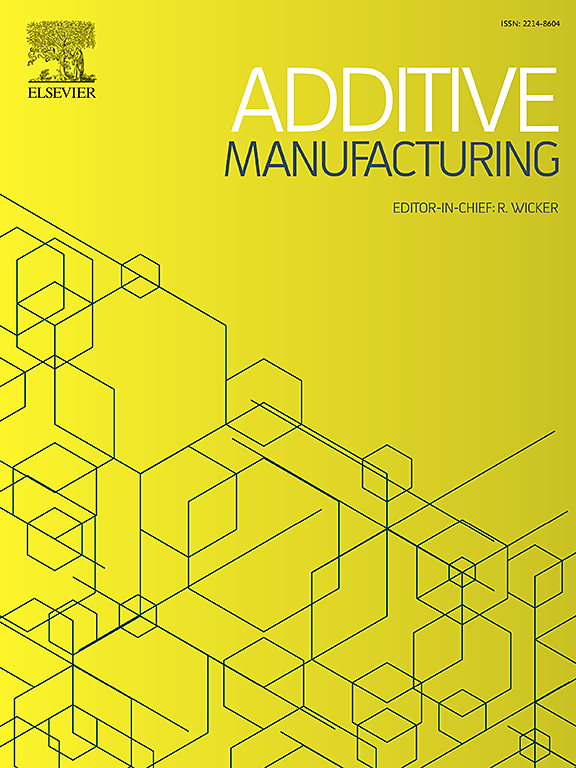用还原光聚合法制备了高HFOM三维抗四手性负泊松比BaTiO3陶瓷
IF 11.1
1区 工程技术
Q1 ENGINEERING, MANUFACTURING
引用次数: 0
摘要
钛酸钡(BaTiO3)作为具有高机电转换性能的无铅压电陶瓷,在水听器和能量收集等领域得到了广泛的应用。负泊松比(NPR)结构在竖向受压时具有抗压性,在水平受压时具有抗压性。该特性为材料设计提供了新的自由度,特别是在需要特定机械响应的高性能应用场景中。本文通过研究亚微米/微米级BaTiO3颗粒的质量比对浆料流变性能和固化性能的影响,以及不同烧结工艺下陶瓷的力学和电学性能,确定了BaTiO3陶瓷的最佳制备工艺。制备的块体BaTiO3相对密度为97.9% %,抗压强度为300.2 MPa,压电应变系数d33为275 pC/N,流体静力性能系数(HFOM)为0.0812 × 10−12 Pa−1。设计并制备了两种正泊松比(PPR)结构的BaTiO3陶瓷,体心立方(BCC)和简单网格立方(SGC),并与相同孔隙率下具有NPR结构的BaTiO3陶瓷的性能进行了比较,证明了NPR结构对BaTiO3陶瓷的性能改善作用。本文从工艺参数优化和NPR结构构型参数设计两方面入手,利用还原光聚合(VPP) 3D打印技术,制备出了具有高静压应变系数dh (520 pC/N)和hfm(88.26 × 10−12 Pa−1)的三维NPR结构BaTiO3陶瓷,比本体BaTiO3高1085倍。研究结果对压电陶瓷的设计和制备具有指导意义,也显示了VPP 3D打印技术在开发高机电响应结构压电陶瓷方面的巨大潜力。本文章由计算机程序翻译,如有差异,请以英文原文为准。
Highly HFOM three-dimensional anti-tetrachiral negative Poisson's ratio BaTiO3 ceramics prepared via vat photopolymerization
As lead-free piezoelectric ceramics with high electromechanical conversion performance, Barium Titanate (BaTiO3) has been widely used in fields such as hydrophones and energy collection. Negative Poisson's ratio (NPR) structures can resist compression in the vertical direction when subjected to compressive force and exhibit an auxetic effect in the horizontal direction. This feature provides new degrees of freedom for material design, especially in high-performance application scenarios that require specific mechanical responses. In this paper, the optimal preparation process of BaTiO3 ceramics was established by studying the influence of the mass ratio of submicron/micron BaTiO3 particles on the rheological properties and curing properties of the slurry, as well as the mechanical and electrical properties of ceramics under different sintering processes. The prepared bulk BaTiO3 had a relative density of 97.9 %, a compressive strength of 300.2 MPa, a piezoelectric strain coefficient d33 of 275 pC/N, and a hydrostatic figure of merit (HFOM) of 0.0812 × 10−12 Pa−1. Two types of BaTiO3 ceramics with Positive Poisson's ratio (PPR) structure, Body-centered Cubic (BCC) and Simple Grid Cubic (SGC) were designed and prepared, and their performance was compared with that of BaTiO3 ceramics with NPR structure at the same porosity, proving the performance improvement effect of NPR structure on BaTiO3 ceramics. In this paper, we started from the two aspects of process parameter optimization and NPR structural configuration parameter design and used vat photopolymerization (VPP) 3D printing technology to prepare Three-dimensional NPR structural BaTiO3 ceramics with high hydrostatic piezoelectric strain coefficient dh (520 pC/N) and HFOM (88.26 × 10−12 Pa−1), 1085 times higher than that of the bulk BaTiO3. The results of this work guided the design and preparation of piezoelectric ceramics and also showed the great potential of VPP 3D printing technology in developing structural piezoelectric ceramics with high electromechanical response.
求助全文
通过发布文献求助,成功后即可免费获取论文全文。
去求助
来源期刊

Additive manufacturing
Materials Science-General Materials Science
CiteScore
19.80
自引率
12.70%
发文量
648
审稿时长
35 days
期刊介绍:
Additive Manufacturing stands as a peer-reviewed journal dedicated to delivering high-quality research papers and reviews in the field of additive manufacturing, serving both academia and industry leaders. The journal's objective is to recognize the innovative essence of additive manufacturing and its diverse applications, providing a comprehensive overview of current developments and future prospects.
The transformative potential of additive manufacturing technologies in product design and manufacturing is poised to disrupt traditional approaches. In response to this paradigm shift, a distinctive and comprehensive publication outlet was essential. Additive Manufacturing fulfills this need, offering a platform for engineers, materials scientists, and practitioners across academia and various industries to document and share innovations in these evolving technologies.
 求助内容:
求助内容: 应助结果提醒方式:
应助结果提醒方式:


